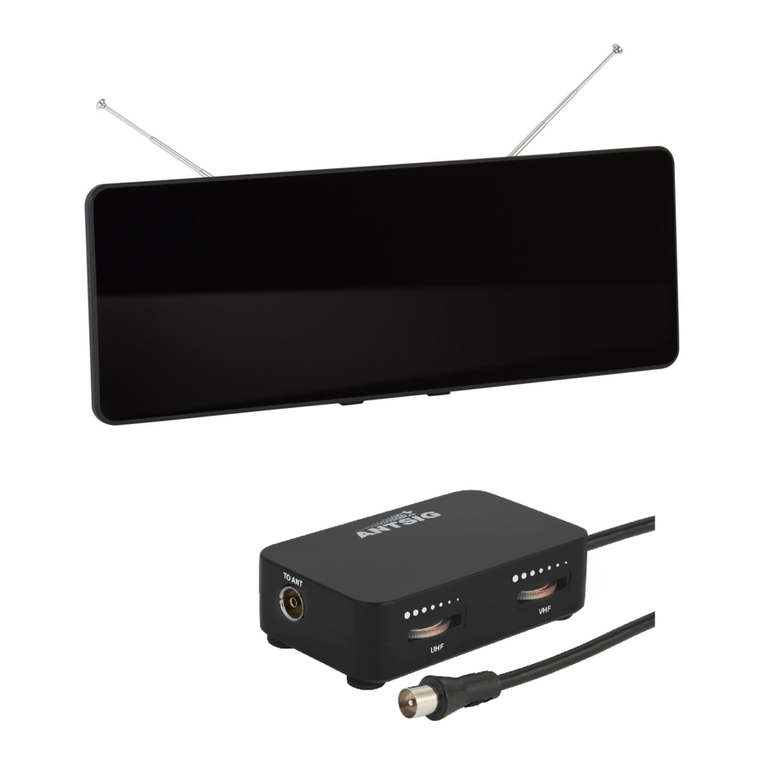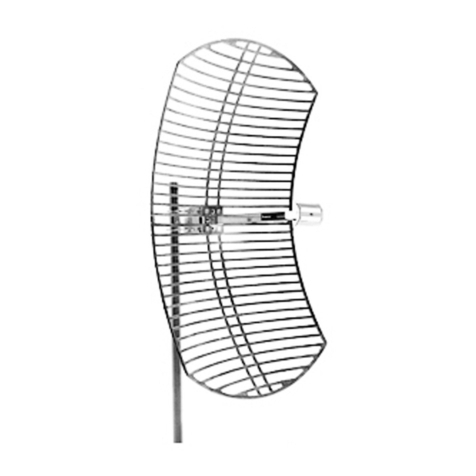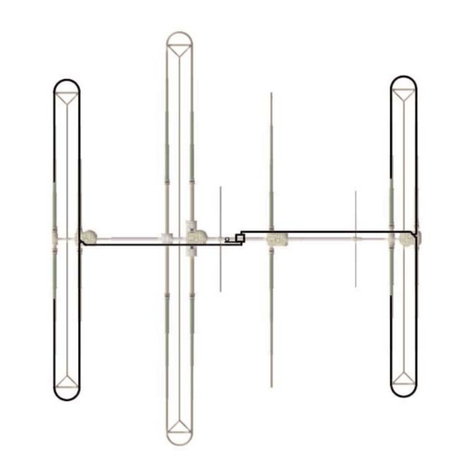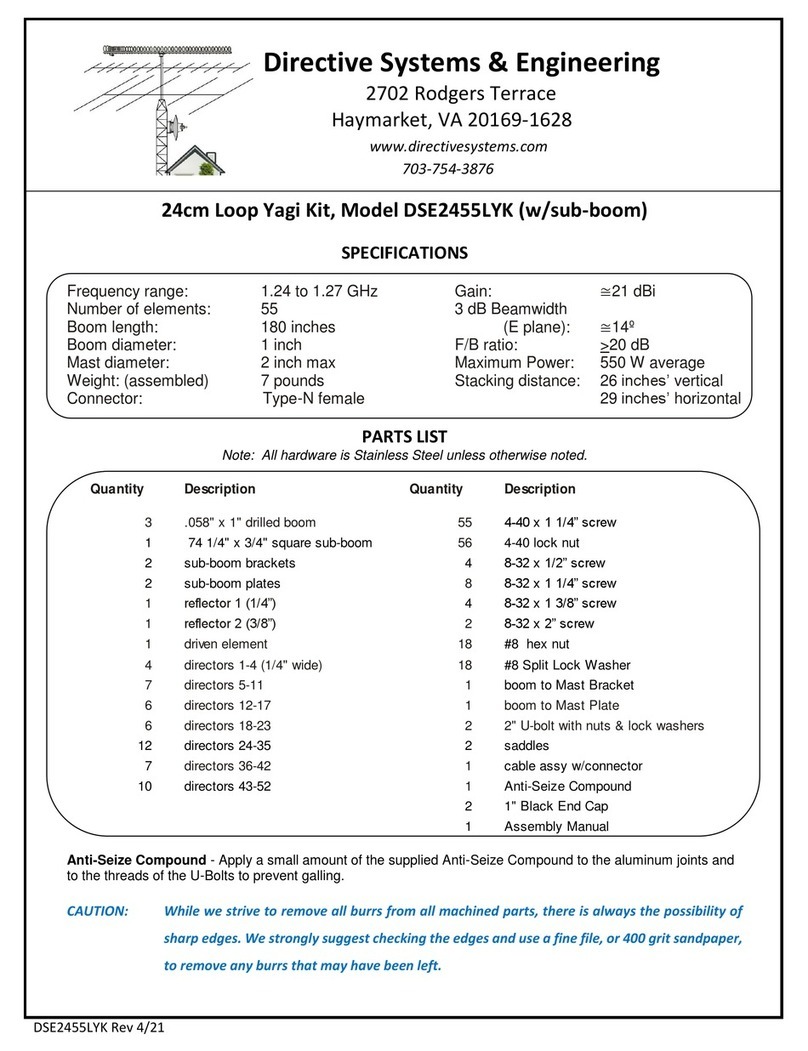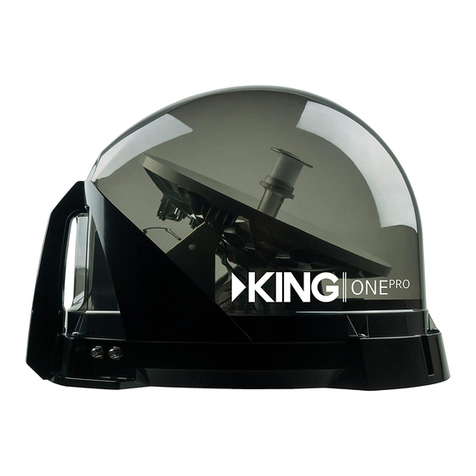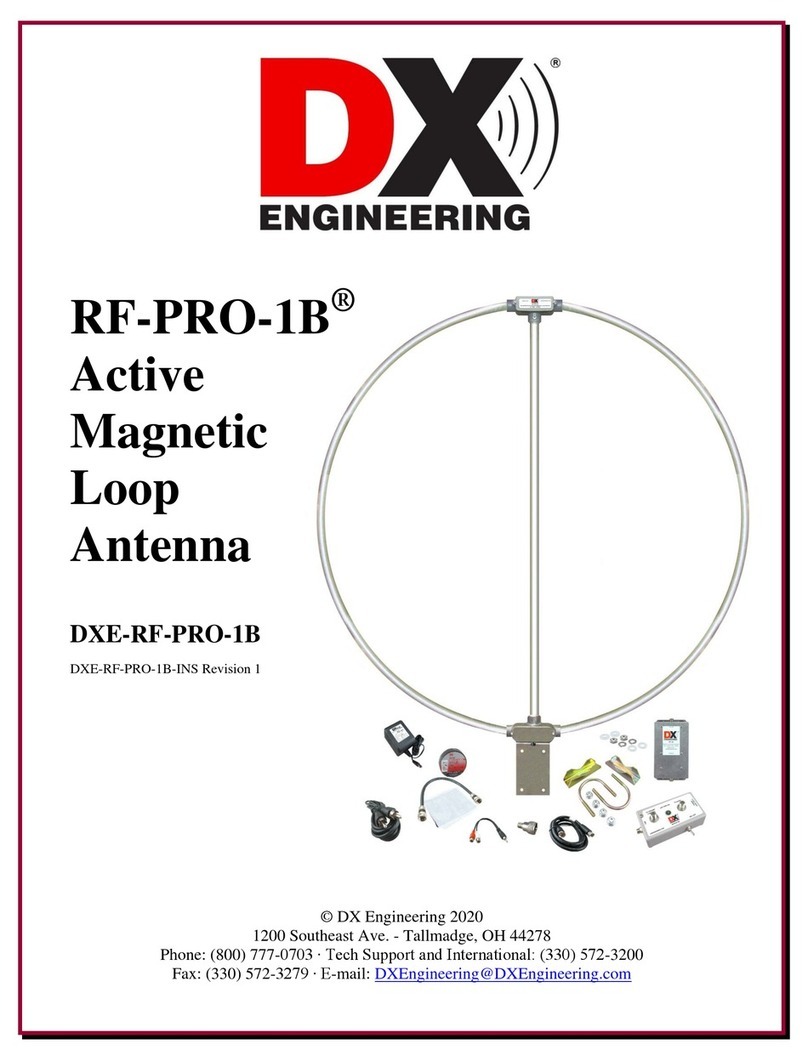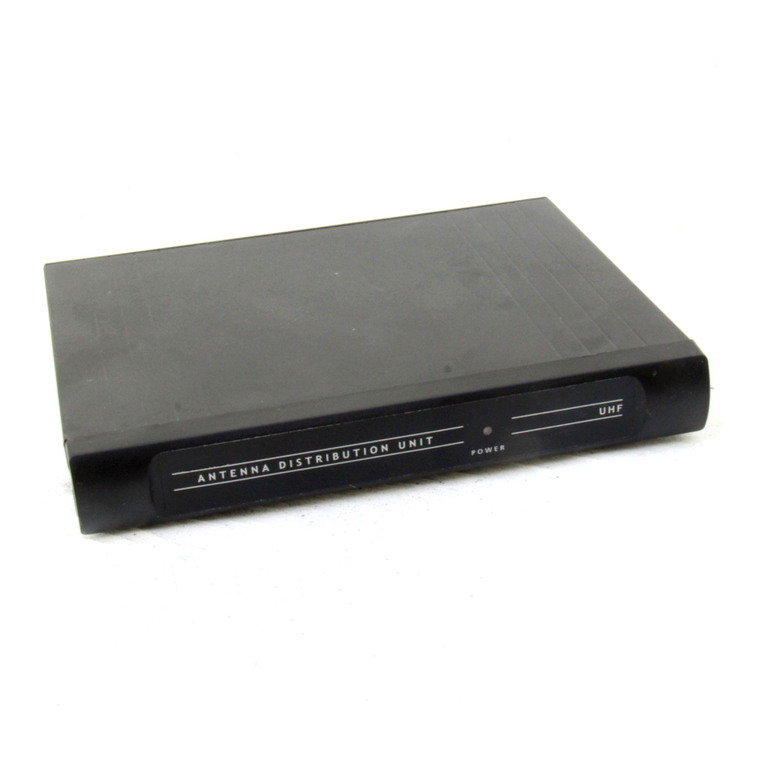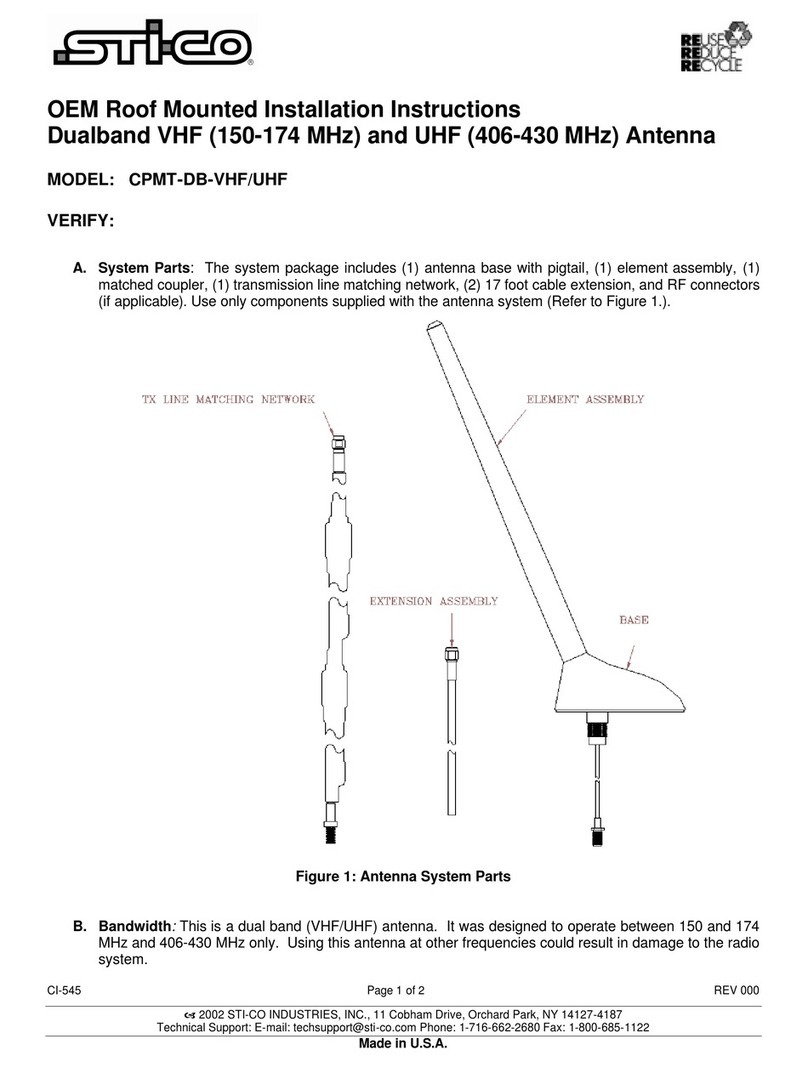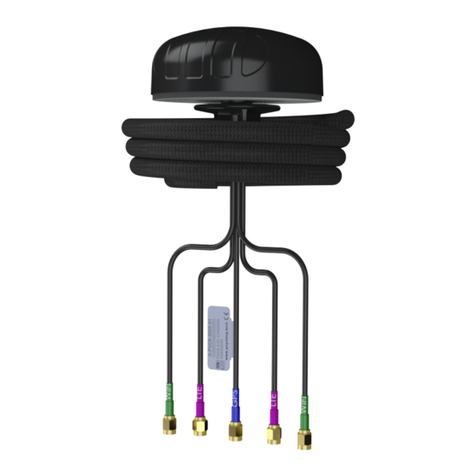Spiderbeam 160-18-4WTH Instructions for use

Spiderbeam 160m Vertical Model 160-18-4WTH
1
160-18-4WTH Manual, Ver. 1.3 26-AUG-2013
Spiderbeam 160m Vertical
Model 160-18-4WTH
VERTICAL CONSTRUCTION GUIDE
Ver. 1.3
We strongly encourage you to read this entire manual once

Spiderbeam 160m Vertical Model 160-18-4WTH
2
160-18-4WTH Manual, Ver. 1.3 26-AUG-2013
before beginning to work.
CHAPTER CONTENTS PAGE
1.0 Description and Theory 5
1.1 Antenna Description 5
1.2 Required Space 5
1.3 Material Description 6
2.0 Construction 7
2.1 Pole Preparation 7
2.1.1 Tips for Clamp Set Assembly 7
2.2 Wooden Base Stake Preparation and Installation 8
2.3 Attaching the Pole to the Base Stake 8
2.4 Raising the Pole for the First Time 9
2.4.1 Raising and Clamping the Pole Segments 9
2.4.2 Using the Optional Guy Belt Set 10
2.5 Mounting the Connection Plate 11
2.6 Measuring and Cutting Ropes and Wires 12
2.6.1 Table of Measurements 13
2.6.2 Cutting Wire and Ropes 13
2.7 Preparing the Radials 13
2.7.1 Preparing Radial Wires 14
2.8 Preparing the Top-Hat 15
2.8.1 Preparing Top-Hat Wires 15
2.8.2 Connecting the PVDF Monofil Line to the 2nd Top-Hat Insulator 16
2.8.3 High Power Option (>1kW) 18

Spiderbeam 160m Vertical Model 160-18-4WTH
3
160-18-4WTH Manual, Ver. 1.3 26-AUG-2013
CHAPTER CONTENTS PAGE
3.0 Installation 18
3.1 Installing the Radiator and Top-Hats 18
3.1.1 Mounting the 4 Top-Hat wires and Vertical Radiator Wire to the Pole 18
3.1.2 Connecting the Vertical Radiator Wire to the Top-Hat Wires 20
3.1.3 Running the Vertical Radiator Wire down the Pole 20
3.1.4 Raising the Pole to its full Height 21
3.1.4.1 Guy Belt Method 22
3.2 Special Instructions for Erecting the Pole in Windy Conditions 24
3.3 Fastening the Top-Hats to their Ground Stakes 25
3.4 Adjusting Guy ropes and Top-Hat Lines 25
3.5 Installing the Radial Network 26
3.5.1 Installing Ground-Mounted Radials 26
4.0 Tuning the Antenna 26
4.1 Tuning Theory and Methodology 26
4.1.1 It’s time to Tune 27
5.0 Appendix 30
5.1 Appendix A: Sketch of the Antenna 30
5.2 Appendix B: Materials and Tools List 31
5.3 Appendix C: Preparing Kevlar Rope 33
5.4 Appendix D: Knots 34

Spiderbeam 160m Vertical Model 160-18-4WTH
4
160-18-4WTH Manual, Ver. 1.3 26-AUG-2013

Spiderbeam 160m Vertical Model 160-18-4WTH
5
160-18-4WTH Manual, Ver. 1.3 26-AUG-2013
1.0 Description and Theory
1.1 Antenna Description
The Spiderbeam Model 160-18-4WTH is a base-fed, [electrical] quarter wavelength vertical
antenna built on a Spiderbeam 18 meter high telescoping fiberglass pole. It uses 4 top-hat
wires to reduce the antenna’s physical height by electrically lengthening the antenna.
This antenna is very easy to build, but does require tuning after it has been erected. It is not
plug and play. Tuning is accomplished by adjusting wire lengths.
Despite being less than 1/8 wavelength in overall height, the Spiderbeam 160-18-4WTH delivers
performance that is very close to that of a full size vertical antenna on 160m –provided you
have adequate space for proper installation of the top-hat wires and radial network.
1.2 Required Space
The space required for this antenna is 35m by 35m, or 1225 sq. meters (~13,000 sq. ft.). This
area should be square, not just rectangular. Minor deviations from this will not cause too much
loss in performance. If you have more space, take advantage of it by placing the ground stakes
supporting the top-hat wires farther away from the pole.
The perfect installation would have many wires used for the top hat, and they would all be
mounted in a horizontal plane at the top of the antenna. In real life installations, this is not
possible. A more practical installation will be one with 4 wires sloping to stakes in the ground
at some distant point away from the antenna (typically 25m).
The antenna itself consists of 3 electrical components: the vertical segment of the radiator; the
top-hat segment of the radiator; and a good set of ground-mounted radials.
The physical length of the vertical segment of the
radiator is limited by the usable length of the fiberglass
pole, which is about 2 meters less than its physical
length.
The top-hat wires must always be the same size. Their
physical length is determined by three factors:
The number of wires used in the top-hat.
The angle of the top-hat wire to the mast.
The ground characteristics at the location.

Spiderbeam 160m Vertical Model 160-18-4WTH
6
160-18-4WTH Manual, Ver. 1.3 26-AUG-2013
The more wires used for the top-hat, the shorter the wires must be and the better the radiation
symmetry of the omin-directional radiation pattern.
The lower the angle of the top-hat wires to the pole, the longer they must be. Every attempt
should be made to keep the angle of the slope of these wires as high as possible - the closer to
being horizontal, the better the antenna will work. This is accomplished by placing the ground
stakes supporting the top-hat wires as far away from the pole as possible (typically 25m).
Ground characteristics at the installation QTH are a given and cannot be easily improved. You
have to accept what you have and realize that this is one of the reasons that we cannot specify
an exact length for the top-hat wires. These wires usually must be adjusted to compensate for
variances in ground characteristics.
The ground-mounted radial network consists typically of 16 radials. In portable installations, as
little as 8 ground mounted radials has been shown to give excellent results, but more is better.
For more information on the deployment of radials and its impact on performance, we recommend
reading the excellent article by Rudy Severns (N6LF), in the December 2010 issue of QST. This
article summarizes the information put forth by Rudy in a series of 7 articles for QEX magazine.
1.3 Material Description:
It is of utmost importance to keep the material used near the top of the pole as lightweight as
possible, yet strong enough to endure the severe winter conditions that prevail during prime low-
band activity.
The Spiderbeam 160-18-4WTH is built with high quality, lightweight but strong material:
The vertical radiator wire is made of Spiderbeam CQ-532 wire. This is AWG-18 stranded
Copperweld wire, with ultraviolet-resistant polyethylene insulation. The wire itself has 1.1
mm diameter, with an OD of 2.2mm. Its breaking strength is 50 kg.
The top-hat wire is made of Spiderbeam CQ-534 wire. This is AWG-26 stranded
Copperweld wire, with ultraviolet-resistant polyethylene insulation. The wire itself has 0.5
mm diameter, with an OD of 1.2mm. Its breaking strength is 10 kg.
The top-hat guy rope is made of PVDF Monofil line. This 1mm diameter line is ultraviolet-
resistant and very durable. Its light weight and good resistance to icing make it optimal for
this use. This is much higher quality than normal fishing line.
The insulators are also made of lightweight polyethylene, are ultraviolet-resistant and very
strong. Despite the low RF current in the top-hat wires, expect very high voltage. As a
consequence, we use 2 insulators in each top-hat line. Do not substitute.
The Spiderbeam Vertical Connection Plate is purpose built for connecting the antenna’s
coax, radiator, and radials. It is also available as a separate option for other use.

Spiderbeam 160m Vertical Model 160-18-4WTH
7
160-18-4WTH Manual, Ver. 1.3 26-AUG-2013
The guy ropes are made with Dacron-covered Kevlar. They are strong and UV-resistant due
to the Dacron. To reduce point pressure which could damage the pole, do not tie the
Kevlar directly to the pole. Instead, tie it to short strips of thick 6mm Dacron rope
provided) and tie it to the pole. Even better, use the optional Guy Belt set for the pole.
The wire for the radials is not included in the kit and must be sourced locally. It may be
copper enamel wire for temporary installations, but should be insulated for long-term or
permanent installations. For top band you will need a lot of wire. The total amount
required depends on the number of radials used and the lengths chosen.
- - - --
2.0 Construction
Before beginning construction, we highly recommend erecting the 18m fiberglass pole at least
one time to familiarize yourself with the physical characteristics of the pole. This will avoid any
unpleasant surprises later. It will also assure that the clamp set is properly adjusted before you
erect the antenna at its final location.
Most of the construction is accomplished during installation. Prior to installation, you can pre-
cut your wires and ropes but in most cases, due to the long lengths used, it is easier to cut them
in the field than in the house.
FORMULA FOR SUCCESS: MEASURE TWICE, CUT ONCE.
2.1 Pole Preparation
It is very important to erect the pole at least once prior to beginning final installation.
If you have not already done so, please assemble the clamp set (included with the pole),
according to the instructions which you will find inside the shipping carton of the pole. These
instructions are also available from Spiderbeam as a PDF.
2.1.1 Tips for Clamp Set Assembly
The Spiderbeam 18m Pole consists of 12 telescoping segments. The segments are counted
from 1 to 12, with segment #1 being the bottom, thickest segment.
There are 11 clamps included with the clamp set. Each clamp will be installed on the bottom of
its pole segment, resting on the segment below it. There is no clamp for pole segment #1.
Counting begins with clamp #2.

Spiderbeam 160m Vertical Model 160-18-4WTH
8
160-18-4WTH Manual, Ver. 1.3 26-AUG-2013
We highly recommend labeling each clamp with the number of the pole segment on which it is
to be installed. To label the clamps, use an “Eding” marker with white, permanent ink. In the
U.S. and Canada, use a “Sharpie” marker with white, permanent ink. If you do not have one of
these markers available, find an alternate way of labeling these clamps. This will make
installation much easier and reduce the possibility of error. Worst case, just tape a piece of
masking tape to each clamp and label it. This will last long enough for the assembly process.
2.2 Wooden Base Stake Preparation and Installation
The wooden base stake is not included in the 160-18-4WTH kit and must be sourced locally.
The purpose of the base stake is to hold the pole in place and keep it from slipping or sliding
under the pressure of the wind. The guy ropes are the pole’s main horizontal support, not the
base stake.
Stake Dimensions: Approximately 5cm x 5cm x 150cm. (2” x 2” x 5’)
Preparation: it is advisable to slightly carve a point on the bottom of the stake using a sharp
pocket knife. CAUTION: WORK CAREFULLY AND DO NOT CUT YOURSELF.
Identify the location for the 18m pole, and using a sledge hammer, pre-drill a hole in the ground
for the installation of the wooden stake by pounding a 30mm to 40mm steel pipe about 75cm
into the ground. * * * PLEASE TAKE CARE TO KEEP THIS STAKE PERFECTLY VERTICAL * * *
Remove this pipe, insert the base stake into the hole and pound it into the hole with a sledge
hammer. * * * PLEASE TAKE CARE TO KEEP THIS STAKE PERFECTLY VERTICAL * * *
2.3 Attaching the Pole to the Base Stake
DO NOT USE COMPRESSION CLAMPS FOR THIS PURPOSE !
Compression clamps, unless used in conjunction with
protective rubber strips like the pole’s clamp set, will
cause damage to the pole.
Instead, use 2 or 3 straps to secure the pole to the
wooden base stake. See the example on the right.
These straps are readily available in any camping
supplies shop. They are used for securing things like
sleeping bags to back packs.

Spiderbeam 160m Vertical Model 160-18-4WTH
9
160-18-4WTH Manual, Ver. 1.3 26-AUG-2013
When you tighten the straps, take care that their metal adjustment head is resting on
the wooden stake, not directly on the fiberglass pole.
If you cannot find these straps, you may substitute 6mm Dacron rope:
Cut two or three pieces of 6mm Dacron rope about 80cm long and prepare their ends by
heating them with a cigarette lighter.
<<< CAREFUL –THE BURNING ROPE IS VERY HOT >>>
2.4 Raising the Pole for the First Time
UNLESS YOU ARE VERY TALL, YOU SHOULD USE A SHORT STEP LADDER FOR THIS WORK.
Note: it is helpful to wear very thin leather gloves when erecting of the pole. This not only
protects your hands, it also gives you a firmer grip on the pole and reduces hand slippage.
PLEASE ERECT THE POLE ONE TIME WITHOUT ANY WIRES ATTACHED.
During the raising of the pole, you will install and adjust the 11 clamps. All clamps will be
slipped over the top of the pole before beginning to erect it.
If you are using the optional guy belt set, you must insert the belts in the proper sequence,
in between the clamps. Read 2.4.2 *before* installing the clamp set in 2.4.1.
TIP: Although you can tighten the clamps using a standard screw driver, it is much easier and
faster to use a 7mm nut driver.
2.4.1 Raising and Clamping the Pole Segments
Carefully raise the inner-most pole segment (segment #12) about 30 or 40 cm and
temporarily tape it to the segment below it, using electrical insulation tape. To
accomplish this, pull the top segment fully out until it pulls the next segment (segment

Spiderbeam 160m Vertical Model 160-18-4WTH
10
160-18-4WTH Manual, Ver. 1.3 26-AUG-2013
#11) with it. While holding segment #11 with one hand lower segment #12 back into
#11 until only about 30 or 40 cm are sticking out. Tape with electrical tape.
You will now slide the entire clamp set, beginning with the largest clamp first (clamp #2),
over the top of the pole. DON’T FORGET to insert the optional guy belts if you plan to
use them. Do this as described below.
First slide clamp #2 over the top of the pole.
Next slide the 2nd largest clamp (clamp #3), over the pole.
Continue sliding the remaining clamps in ascending order over the pole until all 11
clamps are in place. DON’T FORGET to insert the optional guy belts if you plan to use
them. Do this as described below.
CONTINUE:
Holding the top of segment #12 with one hand, remove the electrical tape with the
other hand.
Next, pull segment #12 (the top segment) out from segment #11 (directly below it),
extending it as far as it will go.
Secure these two segments together by holding segment 11 near the top with one hand,
and segment 12 near the bottom with the other hand; pull apart with both hands as you
twist your hands in opposite directions.
Finally, slide clamp #12 into position, such that it sits fully on pole segment #12, but
resting against the top of pole segment #11.
NEXT:
Pull segment #11 out from segment #10; and as above, pull and twist to secure it.
Secure clamp #11 at the bottom of pole segment #11, resting on the top of pole
segment #10.
Continue exactly like this until all of the pole segments are fully extended and secure.
2.4.2 Using the Optional Guy Belts
Whenever possible, please use the optional guy belt set,
available from the Spiderbeam Online Shop. These belts
enable guying the pole in 3 or 4 directions (4 directions
STRONGLY recommended), and reduce the point pressure
exerted on the pole by the guy ropes.
Each guy belt will mount to a specific pole segment, resting on
top of that segment’s clamp (at the bottom).

Spiderbeam 160m Vertical Model 160-18-4WTH
11
160-18-4WTH Manual, Ver. 1.3 26-AUG-2013
The belt with the larger hole mounts on pole segment # 5, so insert the belt between
clamps #5 and #6.
The belt with the smaller hole mounts on pole segment # 9, so insert the belt between
clamps #9 and #10.
DO NOT FORGET TO INSERT THESE BELTS BETWEEN THE CLAMPS
WHEN PLACING THE CLAMPS OVER THE POLE.
This completes the Pole Preparation Section.
Please loosen each clamp except clamp #12, beginning with clamp #2 (the lower clamp)
and carefully drop the pole back down, leaving only the top section (#12) extended so
that the clamps (and belts) do not fall off.
2.5 Mounting the Connection Plate
A connection plate is used for connecting coax, radiator, and radials. The radials connect using
M6 tubular cable lugs. The antenna kit includes 10 M6 cable lugs (8 + 2 spares).
The connection plate mounts to the pole about 10 to 20 cm. above ground, using an 80mm U-
bolt with the SO-239 coax connecter on the bottom as shown in the pictures below.
Proceed as follows:
Fasten the pole to the wooden base stake, pulling the top strap tight, but leaving the
bottom strap loose. This will enable you to pull the pole a few cm away from the stake
for installing the connection plate.

Spiderbeam 160m Vertical Model 160-18-4WTH
12
160-18-4WTH Manual, Ver. 1.3 26-AUG-2013
Insert the rubber strip between the U-bolt and pole.
Fasten the U-bolt to the plate using a washer, lock washer and nut on each side.
When tightening, take care that the U-bolt remains centered on this rubber strip as
shown in the Side View in the picture. <<< VERY IMPORTANT >>>
The bolts, washers and wing-nuts for fastening the radials to the plate may be mounted
later when connecting the radials.
WARNING: IMPROPER MOUNTING OF THIS DEVICE MAY DAMAGE THE FIBERGLASS POLE.
2.6 Measuring and Cutting Ropes and Wires
Measurements which need to be exact should be measured with a long tape measure, rather
than with a folding rule. By measuring once or twice with the tape measure, rather than
multiple times with the folding rule, you reduce the possibility of error.
The length of the vertical radiator wire is not critical down to the last millimeter, because it is
intentionally cut too long and will be shortened later during the tuning process.
The cut length of the top-hat wires is not critical down to the last millimeter, because they may
also also be adjusted in the field when tuning. This will depend on the ground characteristics of
your location.
The field adjustment of the top-hat wires is critical. Even though you may have to adjust their
lengths a few times, you must keep the length of all top-hat wires equal.
FORMULA FOR SUCCESS: MEASURE TWICE, CUT ONCE.

Spiderbeam 160m Vertical Model 160-18-4WTH
13
160-18-4WTH Manual, Ver. 1.3 26-AUG-2013
2.6.1 Table of Measurements
MEASUREMENTS
MATERIAL
QTY
LENGTH
CUT
STAKE DISTANCE
FROM THE POLE
Radiator Vertical Wire
CQ-532
1
~17.5m
18m
N/A
Top-Hat Wires
CQ-534
4
~12.5m
15m
N/A
T-H Extension Rope
PVDF Monofil
4
~18m
20m
25m
Upper Guy Rope
2mm Kevlar
4
~14-15m
17m
7-9m
Lower Guy Rope
2mm Kevlar
4
~10-12m
14m
7-9m
Total CQ-532
~
~
~
18m
~
Total CQ-534
~
~
~
60m
~
Total PVDF Monofil Line
~
~
~
80m
~
Total Rope with 4 dir. Guys
~
~
~
124m
~
Note: The top-hat wires are tied to different ground stakes than the guy ropes.
2.6.2 Cutting the Wire and Ropes
It is up to you whether you choose to cut the wires and ropes before going to the field, or cut
them in the field. Due to their lengths, it is usually easier to cut them in the field.
Radiator Wire: Cut 18m of CQ-532 wire
Top-Hat Wire: Cut 4 pieces of CQ-534 wire, each 15m long
T-H Extension Ropes: Cut 4 pieces of PVDF Monofil Line, each 20m long
Upper Guy Ropes: Cut 4 pieces of 2mm Kevlar rope, each 17m long*
Lower Guy Ropes: Cut 4 pieces of 2mm Kevlar rope, each 14m long*
*Prepare the Kevlar rope ends as described in APPENDIX 5.2.
2.7 Preparing the Radials
The Spiderbeam 160-18-4WTH was designed to be easy to install, using 16 ground-mounted
radials. Using any number between 8 and 24 will give rewarding results. If you use less,
performance will be reduced. If you use significantly more radials, the small gain in radiation
efficiency will be offset by losses in the coax due to higher SWR. We recommend 16 radials as
the “Sweet Spot” for this antenna.
As pointed out earlier, for more information on the deployment of radials and their impact on
performance, we recommend reading the excellent article by Rudy Severns (N6LF), in the
December 2010 issue of QST. This article summarizes the information put forth by Rudy in a series
of 7 articles for QEX magazine.

Spiderbeam 160m Vertical Model 160-18-4WTH
14
160-18-4WTH Manual, Ver. 1.3 26-AUG-2013
2.7.1 Preparing the Radial Wires
The following instructions are based on the assumption that you are using 16 ground-mounted
radials as recommended. If you use more, or fewer, please adjust the numbers yourself.
The ground-mounted radials should each be between ⅛and ¼ wavelength long (20 to 40m).
The length is not critical, but the number of radials is, with more being better. Usually the
length of each is determined by the space available to run the radials. 25 to 30m is a good
length to target.
Due to the length of the radial wires, this work is best performed in the field, directly
where the radials will be installed. You may choose to do this in advance, or do it later
during the installation.
You will need 320 to 640m of wire, eight M6 cable solder lugs, a crimping tool or pliers,
a soldering iron 60w or greater, and liquid electrical tape.
THE RADIAL WIRES WILL BE PREPARED IN GROUPS OF 2.
Cut 2 radial wires, each 20 to 40m long.
Remove 2cm of insulation from one end of each of these 4 wires.
Splice the 2 wires together by twisting them as tight as you can.
Trim the splice to 1.5cm with wire cutters.
DO NOT SOLDER BEFORE CRIMPING.
Insert the splice into a M6 cable solder lug and crimp the lug
using a crimp tool or pliers.
Now solder the wires inside of the solder lug.
Weather proof the 2 wires at the lug with 2cm of heat-shrink tubing, and
seal the other end with “liquid electrical tape”, or similar. You may also use your XYL’s
nail polish for this. If using nail polish, apply 2 or 3 coats, allowing to dry between coats.
This completes the preparation of the first 4 ground-mounted radials.
Now prepare 7 more sets of 2-radials, exactly as you have done above.
This completes the preparation of the 16 ground-mounted radials.
CAUTION: If you use the XYL’s nail polish, don’t let her catch you!

Spiderbeam 160m Vertical Model 160-18-4WTH
15
160-18-4WTH Manual, Ver. 1.3 26-AUG-2013
2.8 Preparing the Top-Hats
For space reasons, it is probably easier to prepare the top hats in
the field.
You will need to solder at least one connection in the field. This
will require a soldering iron with at least 60w.
You will need 4 small weights to attach to the ends of the top-hat
lines to keep them under tension during the installation of the
antenna. For this we recommend large “lead sinkers”
like fishermen use to weight their fishing lines. A 4-oz. to 5-oz.
(112 to 140 gr.) sinker is heavy enough. You may substitute but
do not use heavier weights.
2.8.1 Preparing the Top-Hat Wires
We will prepare the top-hat wires “two at a time”:
Grasp two of the top-hat wires about 15cm below one of their ends, such that the two
ends are the same length above your hand.
Keeping the wires parallel, tie a simple
“Overhand Knot”in the two wires, about
10cm from their ends. Pull this knot as
tight as you can.
Wearing gloves, grasp the two wires
about 30cm below the knot and wrap
two turns of wires around your hand, so
that you can keep the wire from slipping.
Then using pliers pull the end of each
wire individually until the knot is as tight
as you can get it. See picture
You should have about 10cm of wire extending above the knot ( ±1cm). Confirm.
Now prepare the other two top-hat wires exactly like you prepared these two.
Next you will connect an insulator to the other end of each wire:
Insert one end of one of these two CQ-534 top-hat wires through the hole in the end of
an insulator, exiting through the slot.
Pull about 2.4m of wire through the hole and out the slot, then fold it back about 2.4m
such that the distance between the knot and the insulator is 12.5m.

Spiderbeam 160m Vertical Model 160-18-4WTH
16
160-18-4WTH Manual, Ver. 1.3 26-AUG-2013
Now run the end of the wire through
the hole a second time and pull it
tight.
Fold back the rest of the wire onto
itself twisting the excess wire several
times around the longer portion of
the wire as you fold it back.
Measure the distance again between the knot and the insulator. It should be exactly
12.5m. *** THIS IS THE MOST CRITICAL MEASUREMENT OF THE ANTENNA. ***
Secure with two small black UV-resistant wire-ties, one near the insulator and one near
the end of the wire.
Now prepare the other CQ-534 top-hat wire exactly like the first one.
Make sure the distance between the knot and insulators is the same on both wires.
This completes assembly of this pair of top-hat wires for now.
Now prepare the other pair of CQ-534 top-hat wires exactly like the first pair.
The final quality control is to hold all 4 wires in parallel and compare the distance
between the knot and the insulators. Make sure they are all 4 the same length.
2.8.2 Connecting the PVDF Monofil Line to the 2nd Top-Hat Insulator
The top-hat wires have very little RF current in them, but very high voltage. It is advisable to
use two insulators in each top-hat, with a short piece of PVDF Monofil line between them.
<< PLEASE DO NOT GET CREATIVE AT THIS POINT AND SUBSTITUTE BIGGER INSULATORS! >>
When using top-hat wires with this pole, there are THREE critical factors:
1) WEIGHT, 2) WEIGHT, 3) WEIGHT
Note: When pulling the knots in PVDF Monofil line tight, it is advisable to wear thin leather
gloves to keep the line from cutting into your hands. It is also advisable to use one pair of pliers
to pull on the short end of the line tight, but CAUTION VERY IMPORTANT:
DO NOT HOLD ANY PART OF THE LINE WHICH WILL LATER BE UNDER STRESS WITH PLIERS.
For each of the 4 top-hat wires:
Cut a piece of PVDF Monofil line 40cm long.
Insert one end of the line through the free hole of the top-hat insulator.

Spiderbeam 160m Vertical Model 160-18-4WTH
17
160-18-4WTH Manual, Ver. 1.3 26-AUG-2013
Tie a large knot in the PVDF Monofil line about 10cm from this end. Tie any kind of knot
you like; just make sure it does not slip through the hole. You may want to use pliers to
hold the short end while pulling tight. Now, holding the insulator, pull the longer end
away from the insulator, pulling the line tight. The knot will now rest inside the slot of
the insulator. << < Do not trim the excess line! >>>
Insert the free end of the PVDF line through the hole in the end of a new insulator,
extending it out of the slot.
Tie a large knot in this end about 10cm from the end. Again use pliers to hold the small
end and pull it tight. Do not use pliers on the line between the knots.
Now pull the two insulators away from each other. This new knot should slip inside the
slot of the 2nd insulator.
The two insulators will be about 16 to 18 cm apart, but this distance is NOT critical.
The final step is to fasten a PVDF Monofil line to the free hole of the second insulator:
Insert one end of an 18m piece of PVDF Monofil line through the free end of the second
insulator.
Tie a large knot about 10cm from its end and pull it tight, using a pliers to hold the short
end.
Pull the long end away from this insulator, pulling the knot inside the insulator’s slot.
This completes the first of 4 top-hat lines.
Continue with the next three top-hats:
Mount the insulators and PVDF line exactly the same as above.
This completes the preparation of all four top-hats.
When completed, each top-hat should look like this:
TIP: Temporarily tie the far end of the Monofil line to a small weight. We use heavy “lead
sinkers” (140 gr. weights) sourced from a fisherman’s supply shop for this purpose. This should
be just enough weight that it applies some tension to the line as you later begin to raise the
pole with the antenna. <<< Don’t use too much weight. >>>

Spiderbeam 160m Vertical Model 160-18-4WTH
18
160-18-4WTH Manual, Ver. 1.3 26-AUG-2013
2.8.3 HIGH POWER OPTION (>1kW)
If you plan to run more than 1 kilowatt, you must take special precaution. You will need 3
insulators per Top-Hat Wire instead of 2 and you must use 1mm Kevlar rope between the
insulators instead of PVDF Monofil.
Build it exactly as described in 2.8.2, but use 3 insulators with 1mm Kevlar rope between them.
-----
3.0 INSTALLATION
The hardest part of the entire assembly and installation process is
“keeping the wires and ropes from tangling.”
We recommend laying each rope or wire out on the ground in its approximate end
position. It is advantageous to temporarily use small weights to keep some tension on
the lines when they are lying on the ground.
IMPORTANT: PLEASE READ SECTION 3.2 (WIND) BEFORE CONTINUING WITH 3.1
3.1 Installing the Radiator and Top-Hat
In this section you will attach all wires to the pole, dress the wires, splice and solder them
together. You will need electrical tape, a large 8mm UV-Resistant cable-tie, a soldering iron,
60w or more, and liquid electrical tape (or similar) to insulate the connection.
3.1.1 Mounting the 4 Top-Hat Wires and Vertical Radiator Wire to the Pole
You will use a low-tech method for attaching the wires to the pole. It is very simple, lightweight
and effective.
PLEASE STUDY THE PICTURE ON THE NEXT PAGE.

Spiderbeam 160m Vertical Model 160-18-4WTH
19
160-18-4WTH Manual, Ver. 1.3 26-AUG-2013
Note: the pole segments are much smaller than they appear in this sketch. In this sketch the
pole segments were drawn over-size to enable showing the details of the dressing of the wires.

Spiderbeam 160m Vertical Model 160-18-4WTH
20
160-18-4WTH Manual, Ver. 1.3 26-AUG-2013
Begin:
Wrap about 5 or 6 layers of good quality black UV-resistant electrical tape around
segment 11 of the mast, about 5 cm from its top.
Tie an “Overhand Knot” 10cm from one end of the CQ-532 vertical wire.
Following the diagram in the picture, place the vertical wire (CQ-532) and the two pairs
of top-hat wires (CQ-534) against the top of segment #11, such that the 3 knots are just
above the tape.
Wrap an 8mm heavy duty UV-resistant wire-tie around the layer of tape and pull it
slightly tight, TAKING CARE TO ASSURE THAT THE WIRE-TIE IS SEATED IN THE CENTER OF
THE TAPE (as shown in the picture).
Carefully pull all of the wires downward until their knots are seated directly on top of
the wire-tie.
Now pull the wire-tie very tight, compressing the electrical tape. Cut off excess tip.
Wrap several layers of black electrical tape over the wire-tie. This will improve its
resistance to UV. (This step is not shown in the picture).
3.1.2 Connecting the Vertical Radiator Wire to the Top-Hat Wires
Measure 4cm above each knot and cut off the rest of the wire.
Remove 2cm of insulation from the end of all 5 wires.
Splice the 4 top-hat wires and the radiator wire together by twisting them tight.
Solder this connection using a 60w soldering iron, or larger.
After the solder has dried and cooled off, you can cut off some of the excess, leaving
about 1cm of exposed soldered wire.
Finally, insulate the remaining 1cm of exposed, soldered wire with liquid electrical
tape, or with whatever your favorite similar insulating substance is. If you do not
have anything like this, then tape this connection with standard electrical insulating
tape. (BTW, the XYL’s red fingernail polish works well as a substitute! )
3.1.3 Running the Vertical Radiator wire down the Pole
Make sure the 4 top-hat wires are out of the way:
Position the 4 top-hat wires 90° apart and pull the far ends away from the pole until
there is a bit of tension on the wires.
The temporary weights on the ends of the Monofil line should maintain the tension
and keep these wires out of the way.
Other manuals for 160-18-4WTH
1
Table of contents
Other Spiderbeam Antenna manuals
Popular Antenna manuals by other brands
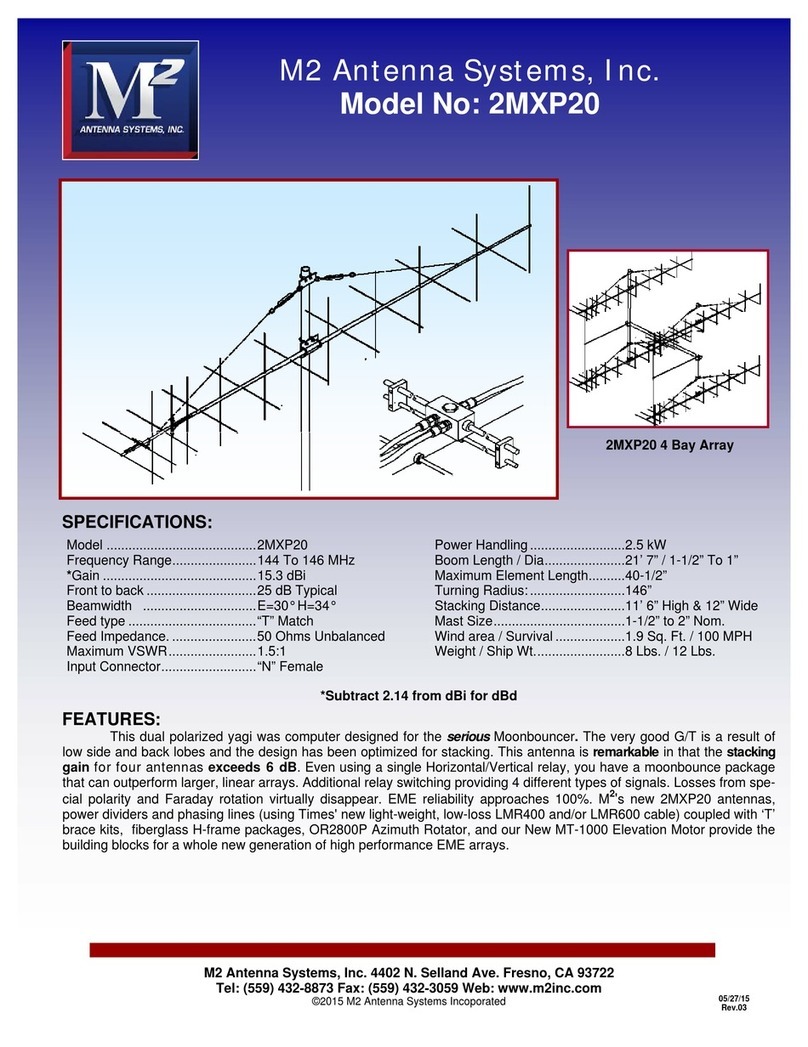
M2 Antenna Systems
M2 Antenna Systems 2MXP20 Assembly manual
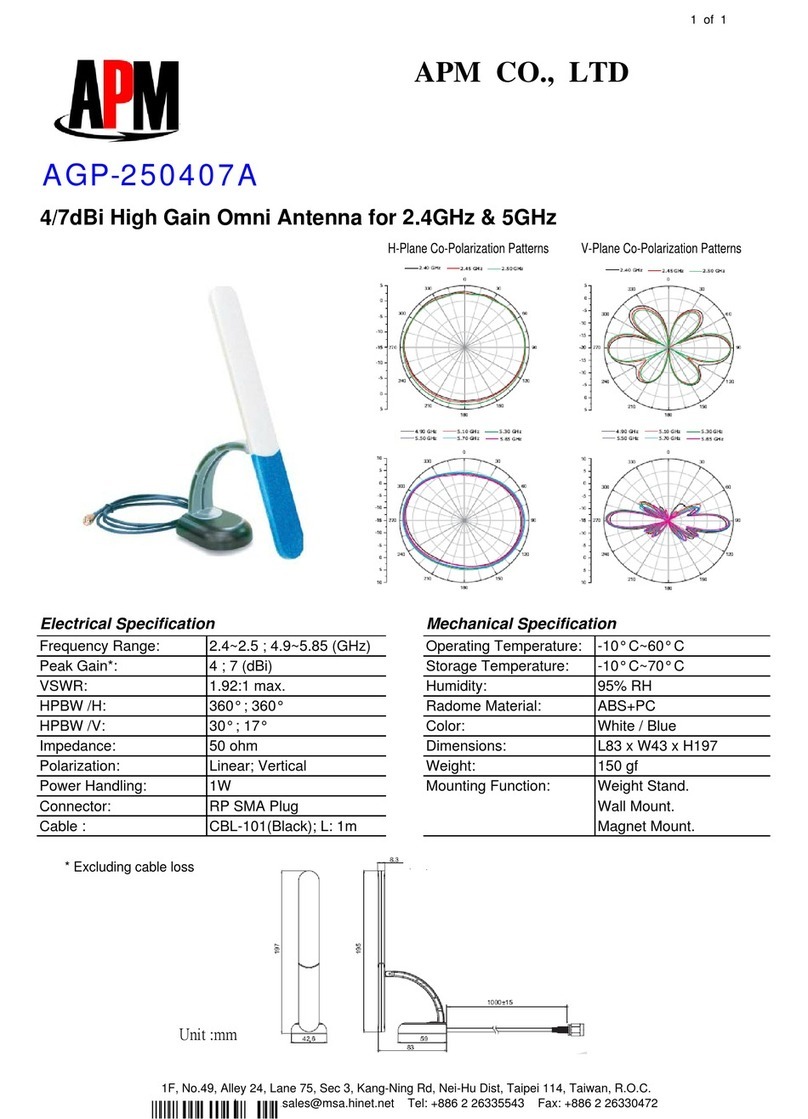
APM
APM 4/7dBi High Gain Omni Antenna AGP-250407A Specifications
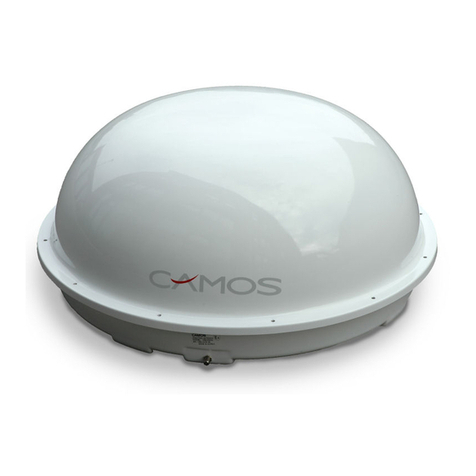
Camos
Camos CSA-1300P instruction manual

RR Electronic
RR Electronic DELTA 1000 S Mounting instructions

RR Electronic
RR Electronic ANTIGUA Mounting instructions
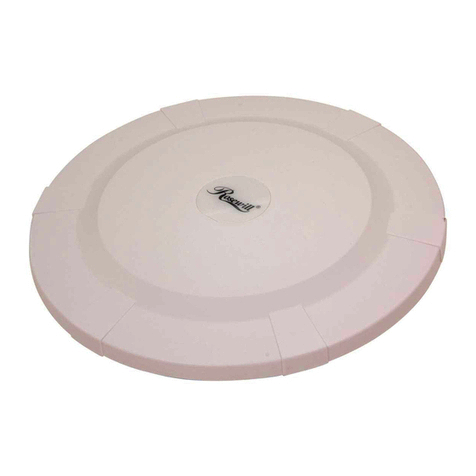
Rosewill
Rosewill RHAA-11001H user manual

